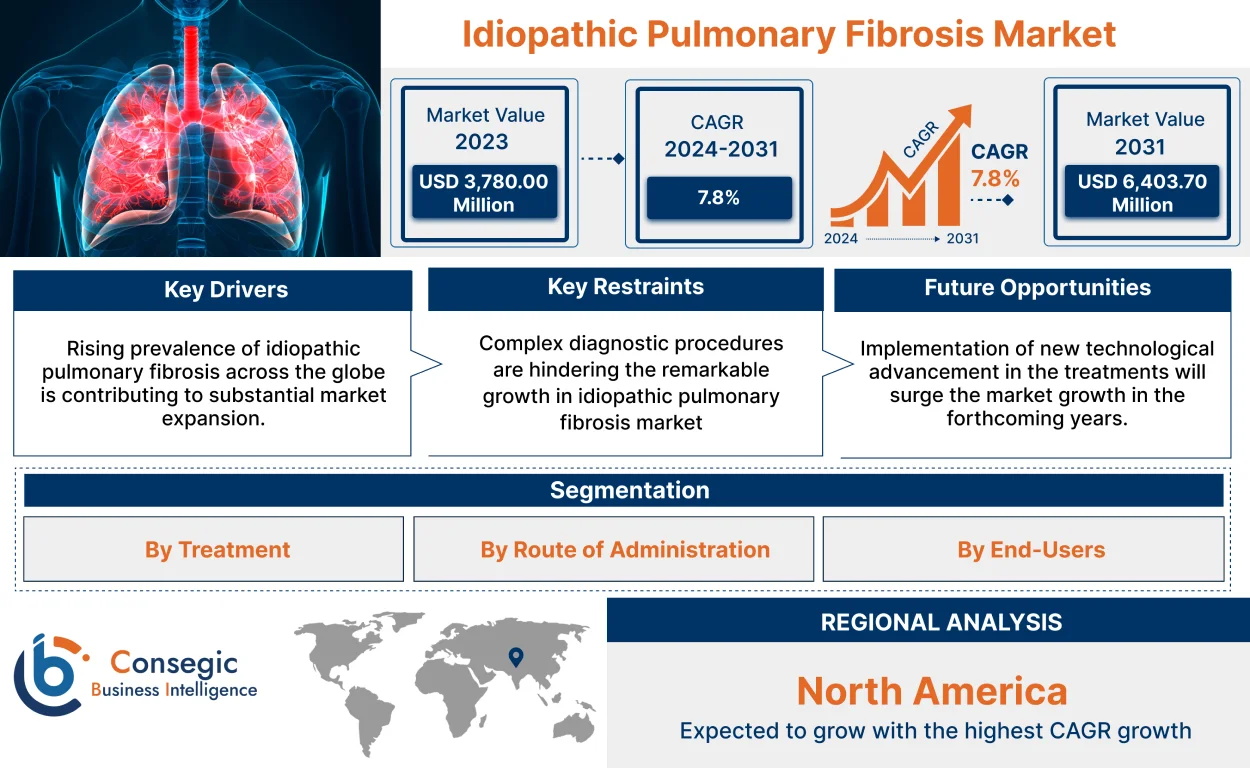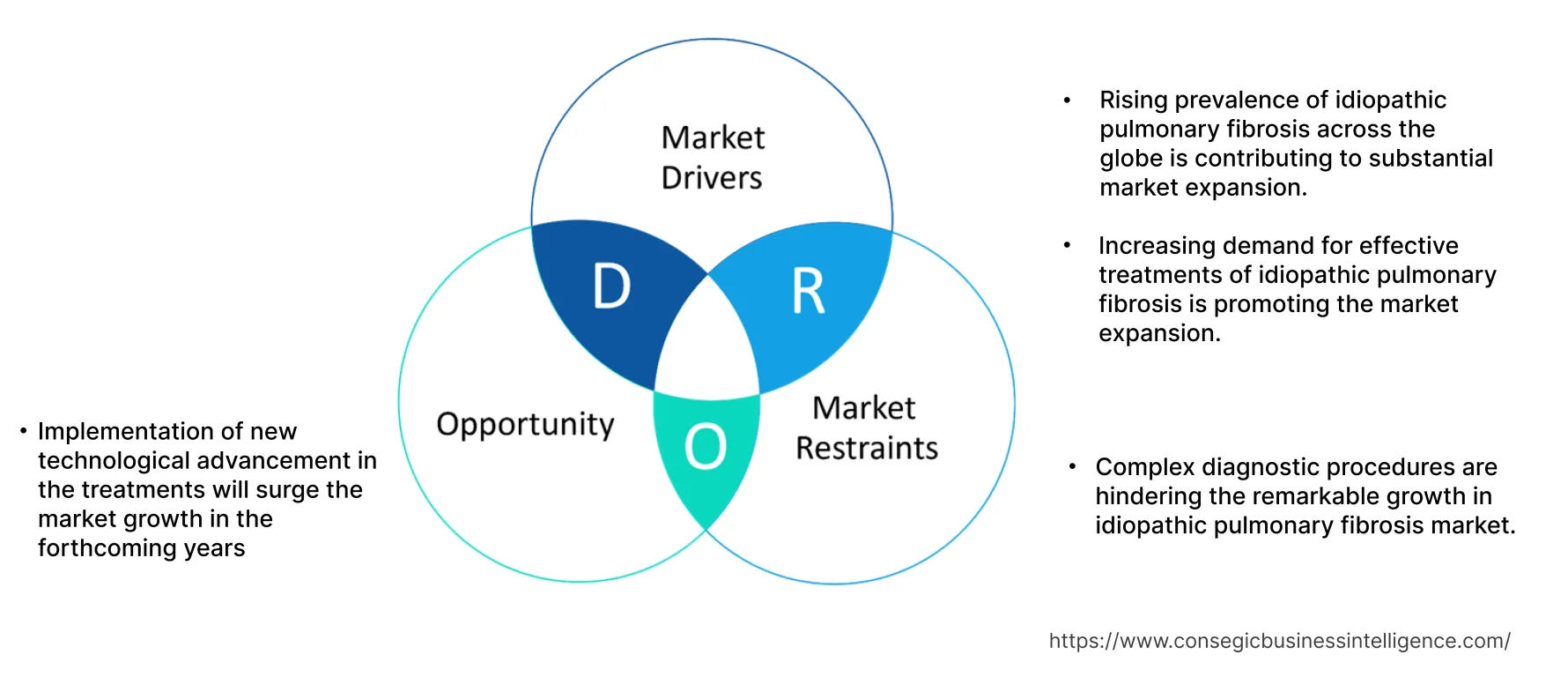- Summary
- Table Of Content
- Methodology
Idiopathic Pulmonary Fibrosis Market Introduction :
Consegic Business Intelligence analyzes that the idiopathic pulmonary fibrosis market size is growing with a CAGR of 7.8% during the forecast period (2024-2031), and the market is projected to be valued at USD 3,780.00 Million by 2023 and USD 6,403.70 Million in 2031.
Idiopathic Pulmonary Fibrosis Market Definition & Overview :
Idiopathic pulmonary fibrosis (IPF) is defined as a type of serious chronic disease that impacts the tissues around the air sacs, or alveoli in the lungs. This condition further develops when the affected lung tissue becomes thick and stiff for unknown reasons. This fibrosis type is the most common type of pulmonary fibrosis. In the case of this condition, the scarring is caused to the lungs. Scarring causes inflammation of the lungs and leads to difficulty in breathing. In addition to this, this condition is typically staged with terms such as mild, severe, early, and advanced based on pulmonary function tests.
Furthermore, this condition usually takes place in middle-aged and older adults. Likewise, as per the analysis, pulmonary fibrosis is diagnosed in children and infants, but this is not a common phenomenon. The lung problem caused by pulmonary fibrosis cannot be cured or repaired. Medicines and therapies do help in slowing down the rate of fibrosis, ease symptoms, and improve quality of life. However, for some people, a lung transplant might be an effective option.
Idiopathic Pulmonary Fibrosis Market Insights :
Key Drivers :
Rising prevalence of idiopathic pulmonary fibrosis across the globe is contributing to substantial market expansion.
The large presence of individuals affected by idiopathic pulmonary fibrosis is one of the main factors driving the productive treatment methods in the idiopathic pulmonary fibrosis market. The increasing number of pulmonary fibrosis is contributing to more diagnosis of pulmonary fibrosis cases. Similarly, the advanced smoking habits of people is another significant factor expanding the spread of pulmonary fibrosis. In addition to this, causes such as viral infections, exposure to pollutants & dust particles, and family history is other predominant factor stimulating the market to grow incessantly.
Furthermore, based on the analysis, the solid presence of individuals diagnosed with pulmonary fibrosis is also fostering the exceptional trends for effective treatments in the overall market. For instance, according to the statistics posted by the Regents of the University of California in 2022, idiopathic pulmonary fibrosis affects more than 100,000 people in the U.S., with 30,000 to 40,000 new cases diagnosed each year and IPF affects 13 to 20 out of every 100,000 people. Generally, the disease is found in people between the ages of 50 and 70 and it affects men more often than women. Therefore, the above-mentioned factors are supporting the high requirement for medications, which is further accelerating the idiopathic pulmonary fibrosis market growth.
Increasing demand for effective treatments of idiopathic pulmonary fibrosis is promoting the market expansion.
Like any other disease, treatment for pulmonary fibrosis is targeted at impeding the course of the disease, easing out the symptoms, and assisting the patients to stay active and healthy. There are several treatments available in the market to which can reduce the rate at which the condition gets worse. However, there is currently no treatment that could block or reverse the scarring of the lungs. Thus, as per the analysis, stimulating the trends for effective and reliable treatment methods, which is further augmenting the holistic market trends.
Moreover, the increasing trends for medications and treatments to relieve the symptoms and further reduce the damage caused to lungs is certainly driving the market to grow in an excellent manner. For instance, according to the data updated by the National Heart, Lung, and Blood Institute (NHLBI) in March 2022, medications such as nintedanib, pirfenidone, & antacids, oxygen therapy, surgeries, and oxygen support are high in trends as a treatment for this condition, owing to their phenomenal effectivity. Hence, contributing to rigorous trends in the idiopathic pulmonary fibrosis market.
Key Restraints :
Complex diagnostic procedures are hindering the remarkable growth in idiopathic pulmonary fibrosis market.
The high requirement for a combination of advanced diagnostic procedures is an important and impactful factor hampering the demand for treatments in the idiopathic pulmonary fibrosis market. The complex diagnosis techniques and methodologies adopted by medical professionals and healthcare consultants is one of the impeccable factors posing a significant threat to precisely cure the patient. In addition to this, the high demand for inputs required from pulmonologists, radiologists, and pathologists to evaluate patients with lung diseases is another factor thwarting the market trends.
Furthermore, the rising recommendation for two or more types of diagnosis techniques is another restraining factor slowing down the market growth. For instance, according to the information updated by the Regents of The University of California in October 2022, in addition to a thorough medical history and physical exams, healthcare professionals suggest a combination of two or more diagnosis methods comprising of pulmonary function test (PFT), high resolution computed tomography (HRCT), blood tests, six-minute walk test, bronchoscopy, surgical lung biopsy. Hence, as per the analysis, the complicated diagnostic processes are significantly decreasing the identification of this condition, which is further limiting the market trends.
Future Opportunities :
Implementation of new technological advancement in the treatments will surge the market growth in the forthcoming years.
The continuous advancement in technology plays a critical role in creating enormous trends and idiopathic pulmonary fibrosis market opportunities. The current progress occurring in AI and machine learning is an excellent factor boosting the new innovations in the treatment market. The evolving research and development techniques and methodologies are expected to guide the holistic idiopathic pulmonary fibrosis market growth. In addition to this, based on the analysis, rising investments in discovery and development of new medications and treatments using agile methods is another dynamic factor expected to fuel the market in the forthcoming years.
Furthermore, the increasing new product developments in treatments by innovative market players is expected to fuel the idiopathic pulmonary fibrosis market in the upcoming years. For instance, in July 2023, Hongkong based Insilico Medicine announced the phase 2 trial of INS018_055, a drug discovered and designed using artificial intelligence (AI) for the treatment of this condition, a chronic disease that causes scarring in the lungs. Therefore, the above-mentioned developments are further expected to drive idiopathic pulmonary fibrosis market trends and opportunities over the forecast period.
Idiopathic Pulmonary Fibrosis Market Report Insights :
| Report Attributes | Report Details |
| Study Timeline | 2018-2031 |
| Market Size in 2031 | USD 6,403.70 Million |
| CAGR (2024-2031) | 7.8% |
| By Treatment | Medications (Pirfenidone and Nintedanib), Oxygen Therapy, Pulmonary Rehabilitation, Lung Transplant, Palliative care, and Others |
| By Route of Administration | Oral, Parenteral, and Others |
| By End Users | Hospitals, Clinics, Rehabilitation Centers, Home Settings, and Others |
| By Region | North America, Europe, Asia Pacific, Latin America, and Middle East & Africa |
| Key Players | Merck KGaA, Boehringer Ingelheim Pharmaceuticals, Inc., Hubei Gedian Humanwell Pharmaceutical Co., Ltd., Daicel Chiral Technologies (India) Pvt. Ltd., Teva Pharmaceutical Industries Ltd., Hefei Home Sunshine Pharmaceutical Technology Co., Ltd., Hangzhou Longshine Bio-Tech CO., Ltd, Cipla, STERIS Pharma, F. Hoffmann-La Roche Ltd, Wellona Pharma, Spectrum Chemical, and Sandoz AG |
| Geographies Covered | |
| North America | U.S. Canada Mexico |
| Europe | U.K. Germany France Spain Italy Russia Benelux Rest of Europe |
| APAC | China South Korea Japan India Australia ASEAN Rest of Asia-Pacific |
| Middle East and Africa | GCC Turkey South Africa Rest of MEA |
| LATAM | Brazil Argentina Chile Rest of LATAM |
| Report Coverage | Revenue Forecast, Competitive Landscape, Growth Factors, Restraint or Challenges, Opportunities, Environment & Regulatory Landscape, PESTLE Analysis, PORTER Analysis, Key Technology Landscape, Value Chain Analysis, Cost Analysis, and Regional Trends & Forecast |
Idiopathic Pulmonary Fibrosis Market Segmental Analysis :
Based on the Treatment :
The treatment segment is categorized into medications, oxygen therapy, pulmonary rehabilitation, lung transplant, palliative care, and others. In 2023, the medications segment accounted for the highest market share in the idiopathic pulmonary fibrosis market and is also expected to grow at the fastest CAGR over the forecast period. Medications are the most common treatment method used for pulmonary fibrosis and it is further bifurcated into pirfenidone and nintedanib. Based on the analysis, the convenient route of administration offered by medications is one of the biggest reason healthcare professionals recommend this treatment type.
Furthermore, robust effectiveness of medications to relieve the symptoms is also contributing to the exceptional segmental expansion. For instance, according to the data published by the American Lung Association (ALA) in November 2022, FDA-approved drugs for pulmonary fibrosis such as nintedanib and pirfenidone have shown in clinical trials to slow down the rate of fibrosis or scarring in the lungs. These drugs are approved for patients with mild, moderate, and severe IPF. Therefore, also contributing to massive expansion of the medication segment in the upcoming years.
Based on the Route of Administration :
The route of administration type segment is categorized into oral, parenteral, and others. In 2023, the oral segment accounted for the highest idiopathic pulmonary fibrosis market share in the market and is also expected to grow at fastest CAGR over the forecast period. The oral route of administration is the most common and convenient method of taking medications. The excellent effectiveness offered by this route of administration type is one of the favorable factors influencing the prosperous segmental expansion in the market.
Moreover, as per the analysis, the expansion of advances in oral route of administration is another versatile factor boosting the segment relentlessly. For instance, according to the article published by the National Library of Medicine (NLM) in February 2023, advantages of oral delivery system such as non-invasiveness, patient compliance, convenience of drug administration, drug solubility, mucosal permeability, and stability in the gastrointestinal tract environment boost its popularity in the treatment solutions. Thus, the afore-mentioned factors are further adding to exceptional segment expansion.
Based on the End Users :
The end users segment is categorized into hospitals, clinics, rehabilitation centers, home settings, and others. In 2023, the hospitals segment accounted for the highest market share in the idiopathic pulmonary fibrosis market and is also expected to grow at the fastest CAGR of 39.03% over the forecast period. Hospitals are the most common End User in the segment owing to the solid potential of hospitals to provide surgeries, medications, therapies, consultations, medical care, diagnosis, and other procedures to facilitate the smooth flow of treatment. In addition to this, as per the analysis, long existence of hospitals and the prolonged trust of most of the patients are other reliable factors fostering segmental expansion.
Moreover, the wide availability of hospitals across the globe is another remarkable factor expected to fuel the segment over the upcoming years by carrying out more diagnostic procedures. For instance, according to the data published by the Electro and Institute for Government in October 2023, British hospitals carried out total 24.4 million diagnostic tests in year 2022-23, which is 5% more than year 2019-20. Therefore, the aforementioned factors support the strong requirement for hospitals, which will in turn propel the idiopathic pulmonary fibrosis market demand over the forecast period.
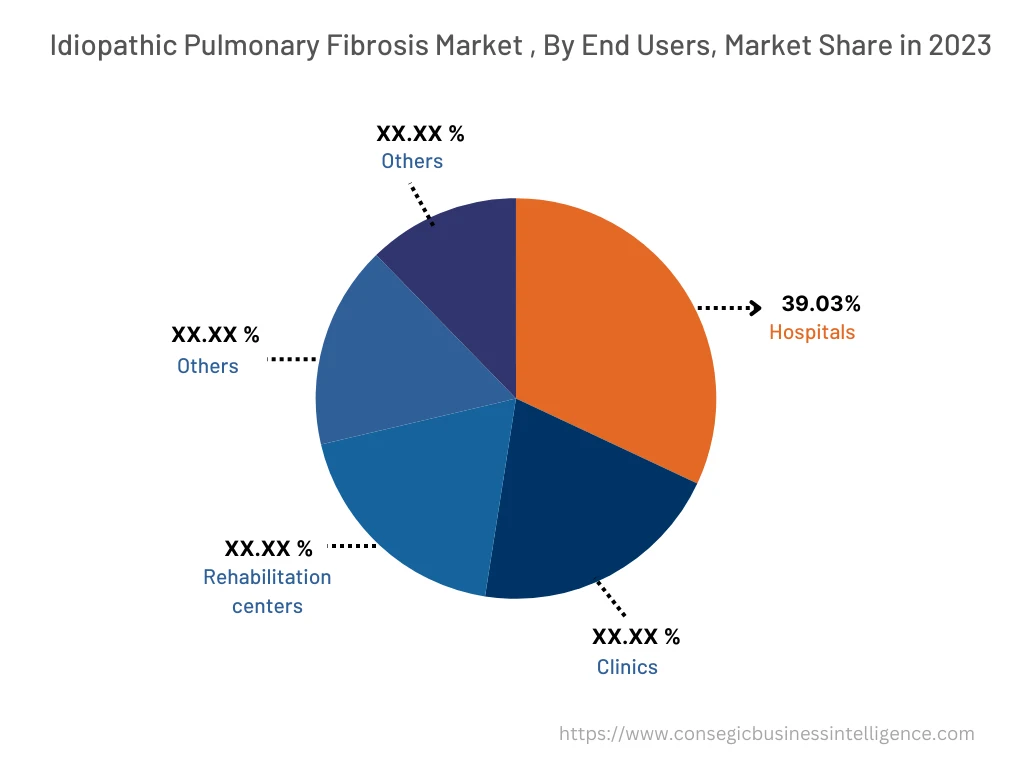
Based on the Region :
The regional segment includes North America, Europe, Asia Pacific, the Middle East and Africa, and Latin America.
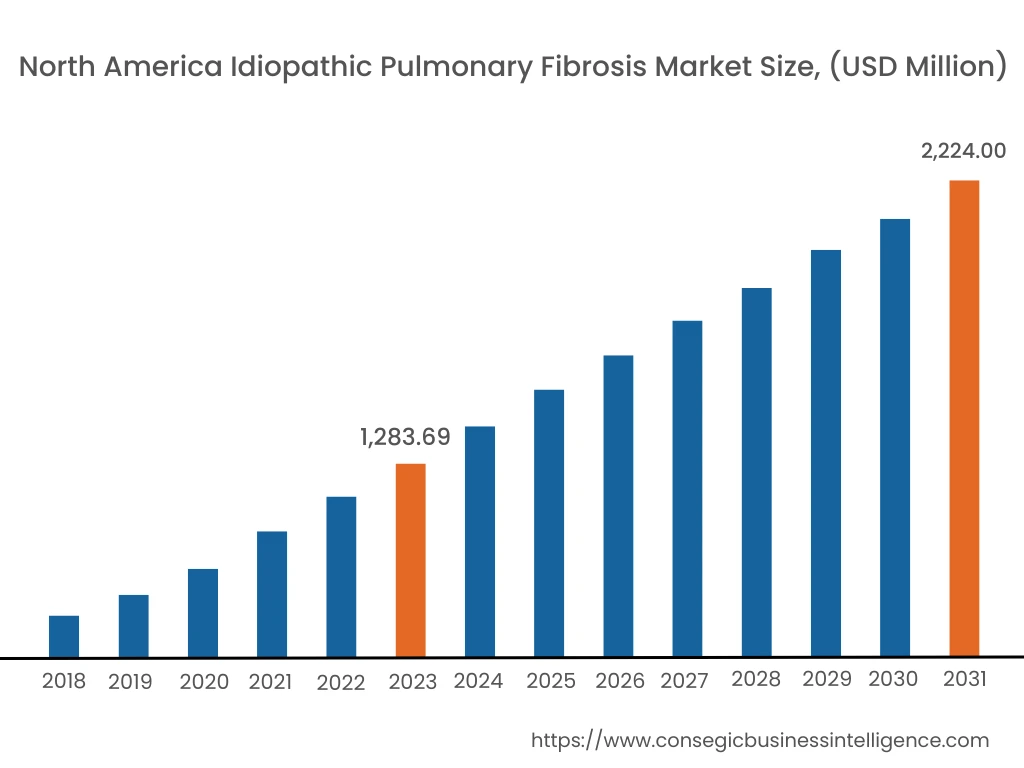
In 2023, North America accounted for the highest market share of 33.96% valued at USD 1,283.69 Million in 2023 and is expected to reach USD 2,224.00 Million in 2031. In the North American region, the U.S. accounted for the highest market share of 61.77% in 2023. According to the idiopathic pulmonary fibrosis market analysis, the expansion of this region is majorly attributed to increased demand for effective treatments for pulmonary fibrosis in North American countries, owing to the high preference of patients. In addition to this, the phenomenal increase in healthcare spending is another incredible factor driving the expansion of the region. For instance, according to the data published by the Centers for Medicare & Medicaid Services (CMS) in December 2023, healthcare spending is the U.S. is increase by 4.1% in 2022, reaching USD 4.5 trillion or USD 13,493 per person, with health spending accounting for 17.3% share of the nation's gross domestic product. Thus, contributing to increased requirements for treatments of pulmonary fibrosis and further propelling the exceptional market expansion in the region.
However, Asia Pacific is expected to grow at the fastest CAGR of 8.4% during the forecast period. The growth of this region is majorly attributed to factors such as increasing demand for pulmonary fibrosis medications by patients to relive the symptoms of this chronic lung disease. Likewise, the rising disposable income and growing awareness about the availability of treatments are other prominent factors expected to support the robust growth of the idiopathic pulmonary fibrosis market in the upcoming years.
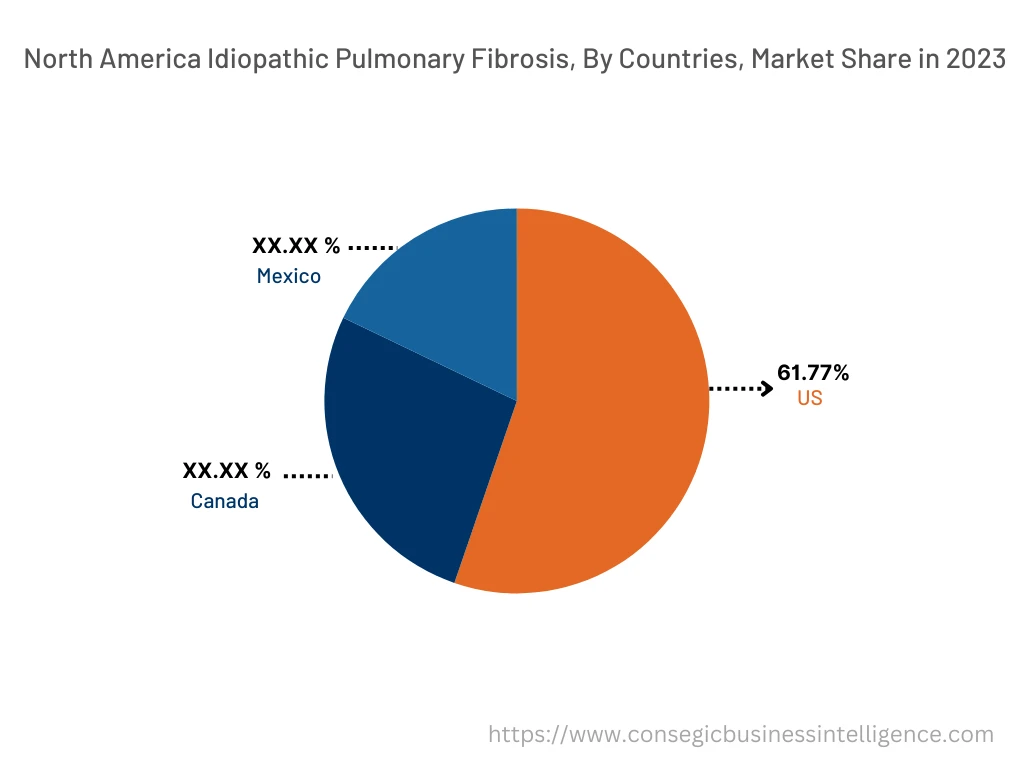
Top Key Players & Market Share Insights :
The global idiopathic pulmonary fibrosis market is highly competitive, with several large players and numerous small and medium-sized enterprises. These companies have strong research and development capabilities and a strong presence in the market through their extensive product portfolios and distribution networks. The market is characterized by intense competition, with companies focusing on expanding their product offerings and increasing their market share through mergers, acquisitions, and partnerships. The key players in the global idiopathic pulmonary fibrosis industry include-
The key players in the market include-
- Merck KGaA
- Boehringer Ingelheim Pharmaceuticals, Inc.
- Hubei Gedian Humanwell Pharmaceutical Co., Ltd.
- Hefei Home Sunshine Pharmaceutical Technology Co., Ltd.
- Hangzhou Longshine Bio-Tech CO., Ltd.
- Wellona Pharma
- Spectrum Chemical
- Daicel Chiral Technologies (India) Pvt. Ltd.
- Teva Pharmaceutical Industries Ltd.
- Cipla
- STERIS Pharma
- F. Hoffmann-La Roche Ltd
- Hangzhou K&M Textile Co.,Ltd
- Sandoz AG
Recent Industry Developments :
- In December 2023, announced the entry into a definitive agreement to acquire selective parts of the LumiraDx group related to LumiraDx's innovative Point of Care technology. The closing of the transaction is expected by mid-2024, and after that the acquired entities will be fully integrated into Roche Diagnostics.
Key Questions Answered in the Report
What was the market size of the idiopathic pulmonary fibrosis market in 2023? +
In 2023, the market size of idiopathic pulmonary fibrosis was USD 3,780.00 million.
What will be the potential market valuation for the idiopathic pulmonary fibrosis market by 2031? +
In 2031, the market size of idiopathic pulmonary fibrosis is expected to reach USD 6,403.70 million.
What are the key factors driving the growth of the idiopathic pulmonary fibrosis market? +
Rising prevalence of idiopathic pulmonary fibrosis across the globe is contributing to substantial market growth. Increasing demand for effective treatments of idiopathic pulmonary fibrosis is promoting market growth.
What is the dominating segment in the idiopathic pulmonary fibrosis market by route of administration? +
In 2023, the oral segment accounted for the highest market share in the overall idiopathic pulmonary fibrosis market.
Based on current market trends and future predictions, which geographical region will have the fastest impact on the idiopathic pulmonary fibrosis market's growth in the coming years? +
Asia Pacific is expected to be the fastest-growing region in the market during the forecast period.
